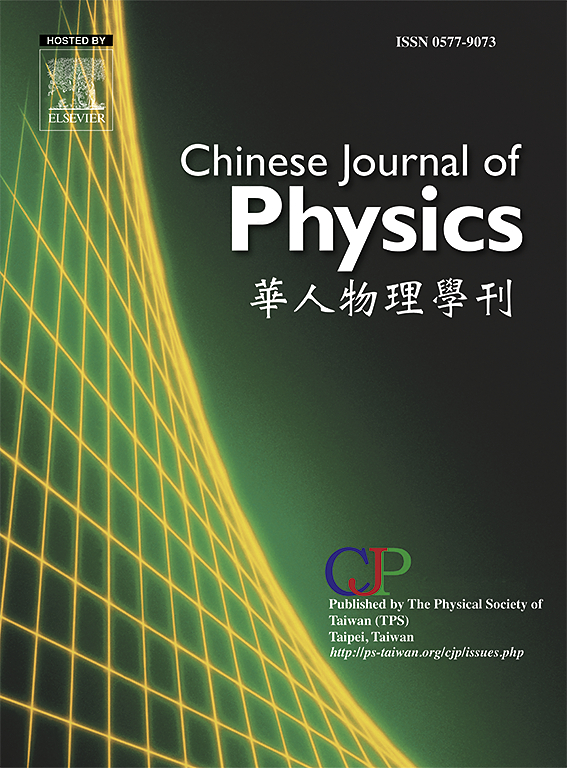Thermal performance and entropy generation in a heated concave chamber filled with NEPCM-water nanofluids
IF 4.6
2区 物理与天体物理
Q1 PHYSICS, MULTIDISCIPLINARY
引用次数: 0
Abstract
A study is conducted using the finite element technique to examine the fluid flow, heat transfer and entropy production in a chamber due to natural convective flow of NEPCM (Nano-Encapsulated Phase Change Material) water nanofluid. NEPCM particles possess a core-shell architecture, wherein the phase change material (PCM) constitutes the core. The chamber has a heated curved (concave type) boundary in bottom, cooled lateral boundaries, and an adiabatic curved (concave type) boundary at top. The lateral boundaries are maintained at an isothermal temperature of T = Tc, whilst the bottom curved boundary is non-isothermally heated to . A detailed analysis of entropy production and heat transfer along with the heat capacity ratio, isotherms, and streamlines is conducted and presented for different significant relevant parameters in the form of suitable graphs and tables. The results of this study revealed that the average Nusselt number values rise while employing NEPCM water as the working fluid compared to the base fluid water. The radius of curvature substantially affects both the average Nusselt number and average entropy production. The maximum percentage rise in average Nusselt number occurs when Stefan number (Ste) is 0.2 and radius of curvature (Rb) is 0.5, about 17.74 %. The most substantial reduction in average entropy production occurs at Ste = 0.2 for Rb = 1, reaching around 27.73 %.

在充满nepcm -水纳米流体的加热凹室中的热性能和熵生成
采用有限元方法研究了NEPCM(纳米封装相变材料)水纳米流体在自然对流条件下的流动、传热和熵产。NEPCM粒子具有核-壳结构,其中相变材料(PCM)构成核心。所述腔室底部有加热弯曲(凹型)边界,侧面有冷却边界,顶部有绝热弯曲(凹型)边界。横向边界保持在等温温度T=Tc,而底部弯曲边界非等温加热到T=Tc+(Th - Tc)sin(πxL)。详细分析了熵产和传热以及热容比、等温线和流线,并以合适的图表形式给出了不同重要相关参数。研究结果表明,与基液水相比,以NEPCM水作为工作流体时,平均努塞尔数值有所上升。曲率半径实质上影响平均努塞尔数和平均熵产。当Stefan数(Ste)为0.2,曲率半径(Rb)为0.5时,平均Nusselt数上升百分比最大,约为17.74%。当Rb = 1时,在Ste = 0.2处平均熵产的降幅最大,达到27.73%左右。
本文章由计算机程序翻译,如有差异,请以英文原文为准。
求助全文
约1分钟内获得全文
求助全文
来源期刊

Chinese Journal of Physics
物理-物理:综合
CiteScore
8.50
自引率
10.00%
发文量
361
审稿时长
44 days
期刊介绍:
The Chinese Journal of Physics publishes important advances in various branches in physics, including statistical and biophysical physics, condensed matter physics, atomic/molecular physics, optics, particle physics and nuclear physics.
The editors welcome manuscripts on:
-General Physics: Statistical and Quantum Mechanics, etc.-
Gravitation and Astrophysics-
Elementary Particles and Fields-
Nuclear Physics-
Atomic, Molecular, and Optical Physics-
Quantum Information and Quantum Computation-
Fluid Dynamics, Nonlinear Dynamics, Chaos, and Complex Networks-
Plasma and Beam Physics-
Condensed Matter: Structure, etc.-
Condensed Matter: Electronic Properties, etc.-
Polymer, Soft Matter, Biological, and Interdisciplinary Physics.
CJP publishes regular research papers, feature articles and review papers.
 求助内容:
求助内容: 应助结果提醒方式:
应助结果提醒方式:


